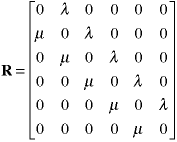For queueing problems like the
ATM example, we typically use  as
the arrival rate with the mean time between arrivals given
by as
the arrival rate with the mean time between arrivals given
by  .
For the service activity we use .
For the service activity we use  as
the service rate with as
the service rate with  being
the mean time for the service activity. For the ATM example being
the mean time for the service activity. For the ATM example  =
2/min and =
2/min and  =
2.5/min. For CTMC's, activities are well represented by their
rate of occurrence, so rather than using a state-transition
network like the one in Fig. 1, we use a rate network as in
Fig. 3. The rate network is easily constructed from the state-transition
network by replacing the activity designation by the rate for
the activity. =
2.5/min. For CTMC's, activities are well represented by their
rate of occurrence, so rather than using a state-transition
network like the one in Fig. 1, we use a rate network as in
Fig. 3. The rate network is easily constructed from the state-transition
network by replacing the activity designation by the rate for
the activity.

Figure 3. The rate network
For computational purposes, we introduce the
rate matrix R whose element  is
the transition rate from state i to j. The general
matrix shown below has maximum state index K but for
some problems the matrix might have infinite dimension. (Note
that in this chapter we use K rather than m as
the maximum state index to conform with the queueing literature.) is
the transition rate from state i to j. The general
matrix shown below has maximum state index K but for
some problems the matrix might have infinite dimension. (Note
that in this chapter we use K rather than m as
the maximum state index to conform with the queueing literature.)

General rate matrix
The rate matrix for the ATM example is shown
below.

Rate matrix for the ATM
The rate matrix for the ATM example allows only
arrivals for state 0 and so has one nonzero entry.

State 5 allows only service completions and
similarly has one nonzero entry.

Every other state allows both events. We have
shown the general rate matrix and the rate matrix for the example
with 0's on the main diagonal. For most situations this will
be true. When computing the steady-state probabilities it doesn't
matter whether the diagonal elements are 0. For some problems
there may be events that cause the system to remain in its
current state and experience some economic effect. In these
cases, positive transition rates may be placed on the diagonal. |

